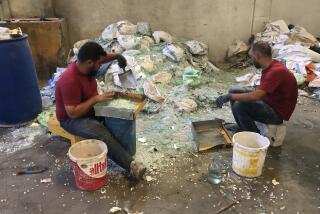Carnival Glass Is Now Fair Game
- Share via
It was 1967 when Donald L. Clark accompanied his aunt and uncle to an antique store in Tustin and saw his first piece of carnival glass.
Today, the walls in his Westminster home are filled with 600 pieces of the colored glass, which sold for about 50 cents for a set of six glasses and a pitcher between 1900 and 1925 when they were made.
Individual plates sold for up to a quarter.
In later years the glass, once called a “poor man’s Tiffany,” became prized as collectibles.
One piece recently sold for $20,000.
Despite the number he owns, Clark says his collection is small even though he considers himself a master collector. “Other collectors have hundreds more,” he noted.
The glassware fell in disfavor with housewives around 1925, and the four companies in Ohio that made it sold their huge inventories to carnivals, which offered them as game prizes, according to Clark.
“The most I’ve paid is $2,500, but most sell for about $1,000,” said Clark, 54, who retired three years ago from Procter & Gamble in Long Beach after working there 25 years.
Some of the collectible glass can still be bought for about $50, Clark said, but added: “Most of the better glass is in the hands of collectors, and it would be just plain luck to find a good one.” He admits that he still patrols antique stores in hopes of “making a strike.”
“The days of finding a really desirable piece is over,” he said. “The super piece just doesn’t show up.”
If he did find a special glass, “I’m not the kind of a man who would talk about it,” he said. “Most people want to show it and want all the collectors to know about it. I don’t care if anyone knows about it.”
He does make an exception with the Orange County Fair.
“I’ve shown it there, and a lot of people get a kick out of seeing it, especially the older folks who might have owned some of them.”
He also takes part of his collection to conventions and membership meetings of the Southern California and San Diego Carnival Glass clubs. He is a member of both.
The Huntington Beach High School graduate said he buys the glass for the beauty of the pieces themselves and the colors in them.
“The glass has different shapes, patterns and colors, and you never get tired of looking at them. It’s Americana,” said Clark, a U.S. Navy veteran. “I also have to look at it as an investment.”
Clark has a warning for those who get caught up in collecting glass.
“This kind of glass is very, very addictive and a very expensive and frustrating hobby,” he said. “You keep seeing pieces you want to buy and buy. It gets into big bucks, but I keep buying the whole shebang. It’s a true sickness.”
Although he feels a strong connection with his collection, “if I needed the money I would sell” it, he conceded.
More to Read
Sign up for Essential California
The most important California stories and recommendations in your inbox every morning.
You may occasionally receive promotional content from the Los Angeles Times.









